Battling Invasive Species Across The National Park System
A National Parks Traveler Special Project
Mosquitoes that carry viruses deadly to native birds at Haleakalā National Park. Reptiles that can grow to four or five feet in length and devour eggs of birds, alligators, crocodiles and turtles at Everglades National Park. Plants and trees that can transform landscapes by not just overrunning native vegetation, but also by being more prone to wildfire.
For the past year, Rita Beamish, Kim O'Connell, Lori Sonken, and Patrick Cone worked with National Parks Traveler Editor Kurt Repanshek to present you with a series of stories highlighting the threats non-native species pose to the National Park System. They threaten native flora and fauna, impact structures, and cost the National Park Service millions of dollars to battle. In some areas the Park Service is making good progress, in others the challenge is daunting. While this project has concluded, the Traveler will continue to cover the issue in spot stories as merited. For now, we'll leave you with the stories we produced.

Quagga mussels have infested the waters of Lake Powell at Glen Canyon National Recreation Area/Kurt Repanshek
The Invasion Of The National Park System
GLEN CANYON NATIONAL RECREATION AREA -- Rising 30 feet and more above the blue waters of Lake Powell, the gray, crusty band of mussel shells reflects an invasion that has swept through the watery ecosystem practically unimpeded.
Quagga shells, an Asian native brought to North America in the ballast of ships, are cemented to the sandstone walls that cradle the hallmark of Glen Canyon National Recreation Area in southern Utah and northern Arizona. Skeletal evidence of the invasion has been revealed by the lake's dropping pool that literally left the invaders high and dry.
In a small handful of years since the species was discovered clinging to boats and dock timbers at the NRA’s Wahweap Marina, the small, sharp-edged shells have become about as ubiquitous as the “bathtub ring” that discolors the ruddy sandstone and reflects the dropping lake level caused by a long-running drought.
The mussels affect both the ecosystem of Lake Powell and the recreational pursuits of many who come to fish, powerboat, Jetski, and simply cool off during the hot summer months. But the invasion, and the ecological and economical impacts the mussels cause, is not the only one confronting the National Park Service as it struggles to preserve natural resources – plant, animal, fish, and fowl – across the National Park System.
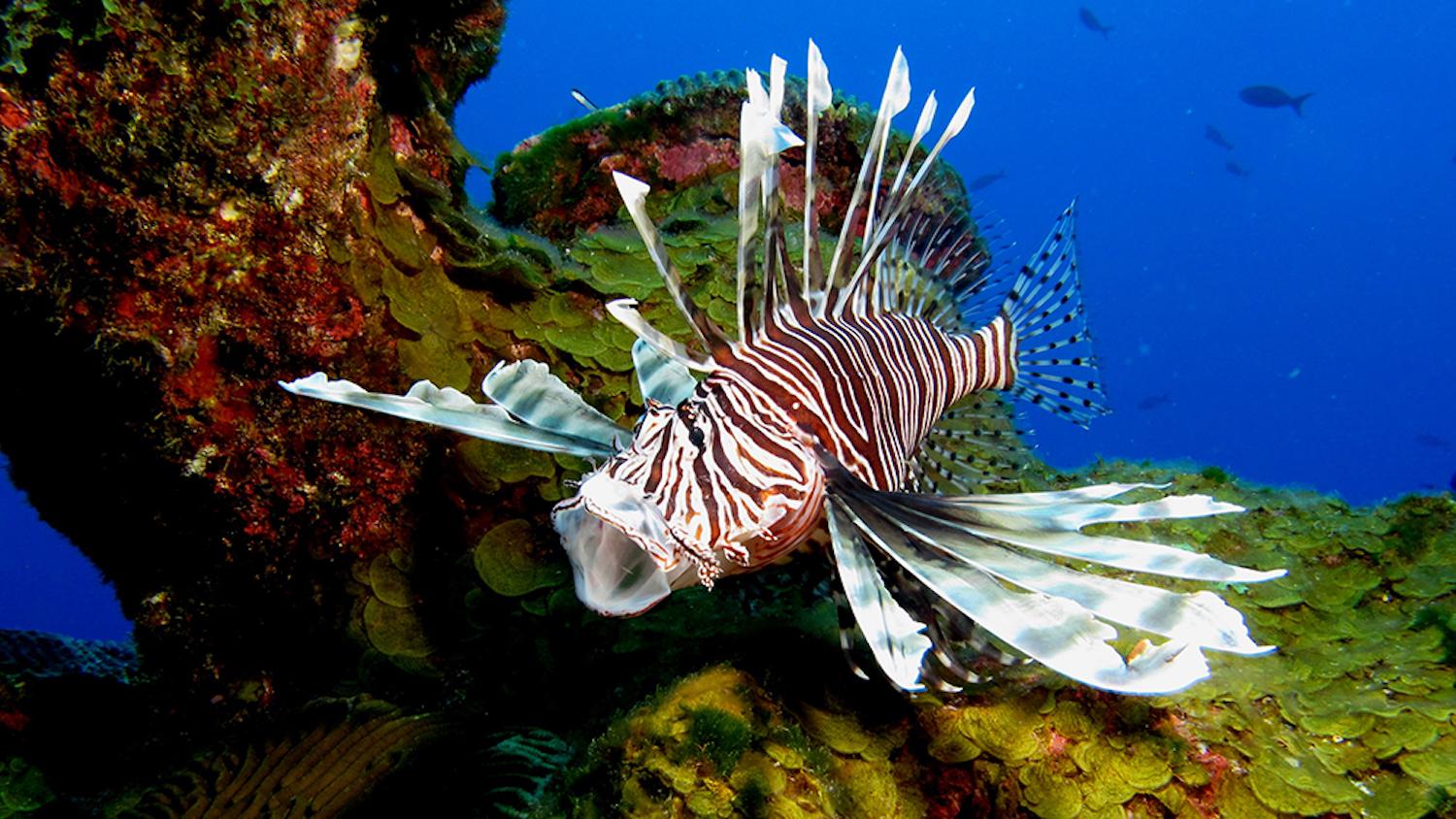
Lionfish are just one of the predatory invasive fish species the National Park Service is battling/USGS
Invasive Fish in National Parks
Voracious, deadly invaders ply national park waters
Aquatic ecologist Danny Boiano loves fish, grew up fishing, studied fish in Yosemite National Park for his master’s degree. So is it odd that today Boiano’s National Park Service job centers around eradicating entire fish populations?
Not when the fish are among the invasive species that infest national park waters. In Sequoia and Kings Canyon national parks, where Boiano works, non-native trout have upended the natural ecosystem, notably devouring mountain yellow-legged frogs and their young, contributing to the frog’s listing as an endangered species.
Boiano wants to return some glacier-carved lakes in California’s High Sierra to their natural state: fishless. That’s how they all were before humans introduced trout for anglers, as far back as 1870, when frogs were an abundant, key component of a vibrant mountain habitat.
To restore the natural balance, Boiano and colleagues, like peers across the park system, have to get rid of the harmful intruders.
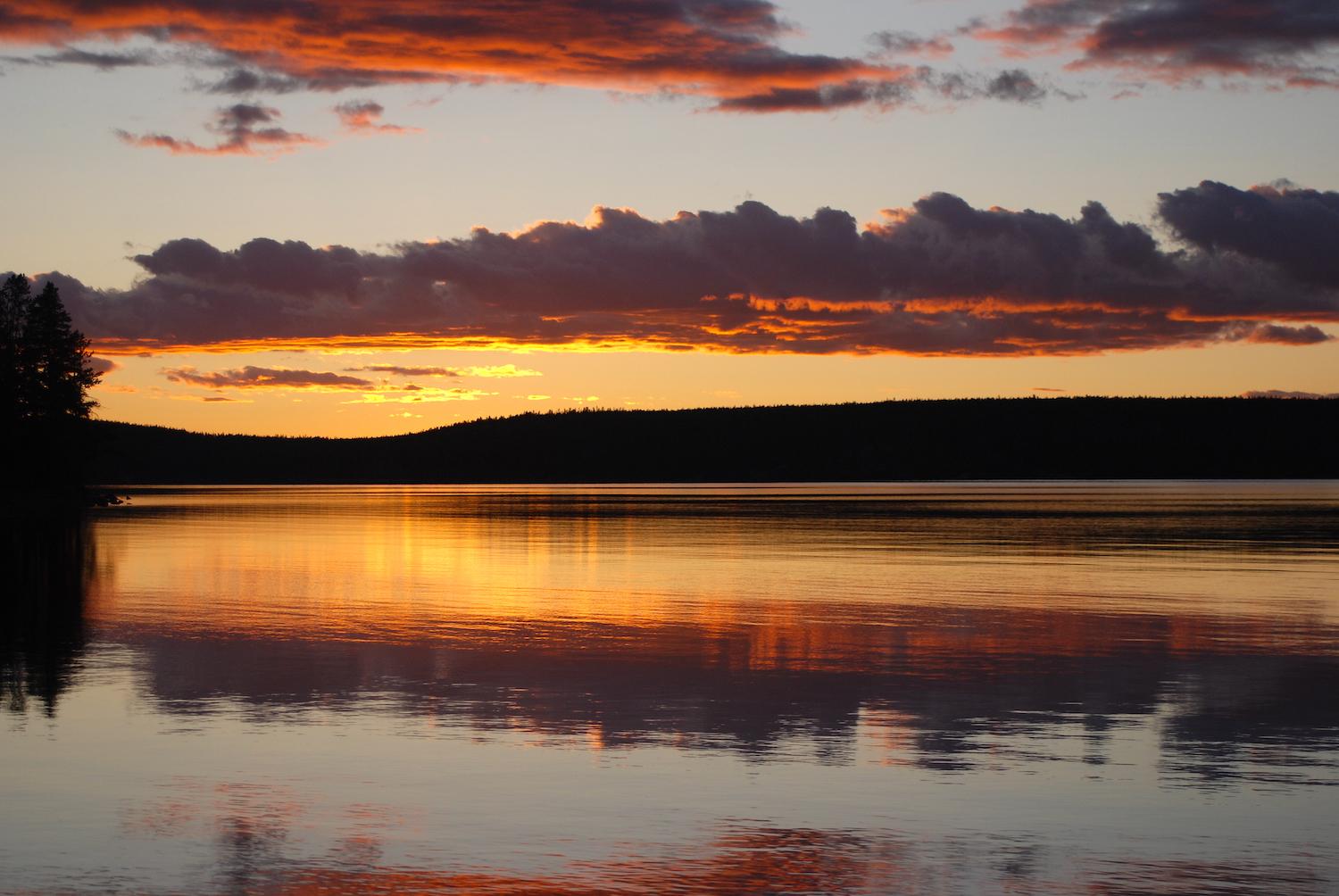
An invader plies the waters of Yellowstone Lake in Yellowstone National Park/Kurt Repanshek
The Unknown Cost Of Invasive Species In The National Park System
It probably seemed like a good thing at the time, introducing lake trout into Lewis and Shoshone lakes in Yellowstone National Park in 1890 to give anglers a bigger catch. But when the big lunkers were illegally deposited into nearby Yellowstone Lake sometime in the 1980s, the predator nearly devoured the native population of Yellowstone cutthroat trout, an iconic species in its own right as well as a key food source for grizzly bears, otters, and osprey, before its discovery in 1994.
“We thought we were doing a good job. But the reality is, we didn’t act aggressively or quickly enough. We almost lost a keystone species,” said Cam Sholly, Yellowstone's superintendent.
Today, the park pays contractors who use hydraulic lifts on fleets to hoist 6,000 miles of gillnets filled with lake trout from the lake. More than 3.4 million lake trout have been removed, but crews might never entirely wipe out the population. The gillnet operation costs about $2 million annually, and lake trout removal expenses are expected to continue in perpetuity.
“We have basically a lifetime investment requirement in order to keep the lake trout where it needs to be. We’ll never fully eradicate the lake trout,” said Sholly.
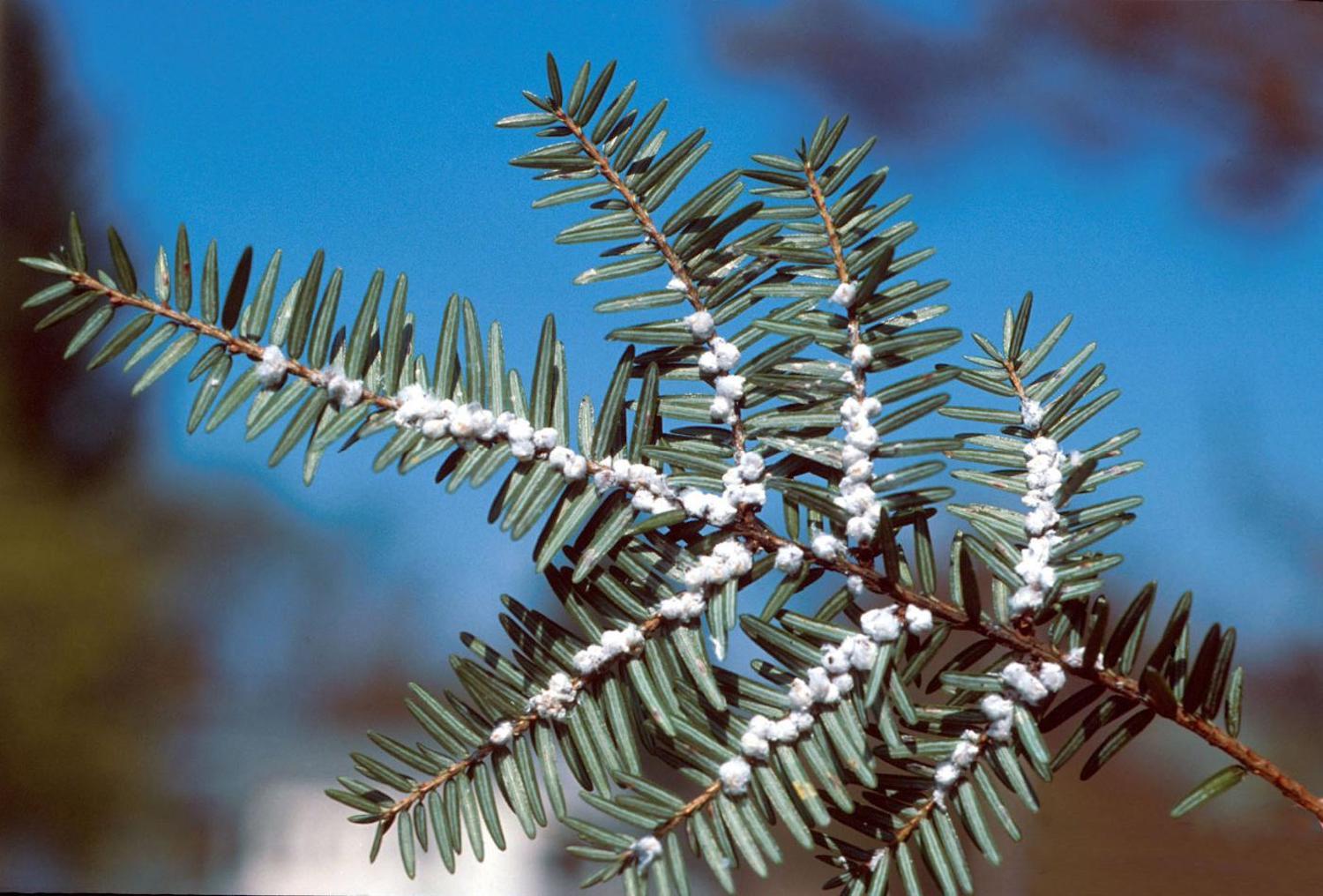
The white puffs are evidence of hemlock woolly adelgid infestation. / Michael Montgomery, USDA Forest Service
Forest Keepers
The National Park System is an essential laboratory—and also a battleground—in the management of invasive pests.
GATLINBURG, Tennessee -- It’s a misty morning in Great Smoky Mountains National Park. Fog laces through the trees on either side of the park road as I head towards my destination, the Twin Creeks Science and Education Center, a National Park Service facility on the park's Tennessee side. All around me is a forest so lush and dense it feels like something out of a fairy tale—a mix of hemlocks, pines, maples, oaks, and countless other species. Inside Twin Creeks, however, a different story is being told, a story of scientists at work: Maps and charts depict vegetation types and different data sets on the park's forest health, and bookshelves are heavy with scientific reports and conference proceedings.
As the park's supervisory forester, Kristine Johnson knows the park's trees pretty well—and not just species, but sometimes individual trees. She was hiking in the park this past summer when she came across a notable Carolina hemlock tree that had fallen. A fellow ranger had already cut the tree to clear the trail and, in doing so, had counted the rings back to 400 years.
“It’s not unusual to see hemlocks that are 400, 500 years old,” Johnson tells me, adding that eastern hemlocks routinely reach well over 100 feet in height. “The ‘redwoods of the East,’ they are called.”
Unfortunately, these oldest, largest hemlocks are highly vulnerable to a sap-sucking invasive pest called the hemlock woolly adelgid, which was first introduced to the eastern United States on infested horticultural material in the mid-1950s and has now caused extensive tree mortality and decline throughout the eastern species’ historic range. Like many other national parks and forests, Great Smoky Mountains foresters are working to protect the park’s trees from the growing scourge of invasive insects and tree pathogens. The park, considered one of the world’s most biodiverse, contains about 100 native tree species in total, and about 20 percent of its forests are old growth.

National Park Foundation philanthropic dollars have helped remove invasive cattail vegetation in Voyageurs National Park/NPS
Charitable Dollars Help In Fight Against Invasives In National Park System
National park philanthropy doesn't stop when it comes to trail and campground maintenance, science and research, or bringing inner-city youth to a park. Each year nearly $1.5 million from the National Park Foundation goes towards battling invasive species across the system.
Each year, the foundation receives donations targeted for invasive species removal work in the National Park System.
"The National Park Foundation funds approximately $1.4 million annually on service/climate corps projects that have a built-in invasive species component, whether it's directly removing the vegetation, trail work that involves invasive species, or fire mitigation," said Jason Corzine, the foundation's vice president who oversees strategies around the foundation's work in the area of protecting and preserving resources in the park system.
"Our natural resource program will spend about $690,000 this year on invasives work," he told the Traveler. "Invasives is a component of the overall projects that we fund in the natural resource space. Going forward, I expect that amount to be a typical future average as donor interest in this work continues to grow. Last year we funded approximately $200,000 for invasive related projects."

Crews remove Russian olive trees by hand along the Escalante River in Glen Canyon National Recreation Area/Kurt Repanshek
Vegetative Invaders In The National Parks
GLEN CANYON NATIONAL RECREATION AREA -- Ducking and weaving around branches and avoiding patches of prickly pear cactus, all under a glaring sun in midday heat climbing towards 100° Fahrenheit, the crew scanned the thick vegetation along the Escalante River deep within Glen Canyon National Recreation Area for the showy, silvery leaves of a tree that shouldn’t be here.
Though long considered a lovely ornamental able to break the wind, provide shelter from the sun, and slow erosion, Russian olive more recently has been branded a noxious weed on public lands, one that will overrun native willows and cottonwoods that normally crowd riverbanks, and even mute the natural, and needed, floodwaters that monsoonal rainstorms can spur.
The U.S. Forest Service views the species as “problematic in the Southwest because it favors riparian communities and other moist environments.”
“As populations increase, Russian olive crowds out desirable native riparian trees such as cottonwood and willow, thereby reducing flora and fauna species diversity. Because of its ability to colonize streambanks, Russian olive can alter the natural flooding regime and reduce availability of nutrients and moisture,” the agency said in a 2014 publication.
With:
National Parks Traveler Editor Kurt Repanshek backpacked in with the crew from Grand Staircase Escalante Partners to learn more about this project and watch them at work and returned with this Audio Postcard From The Parks.
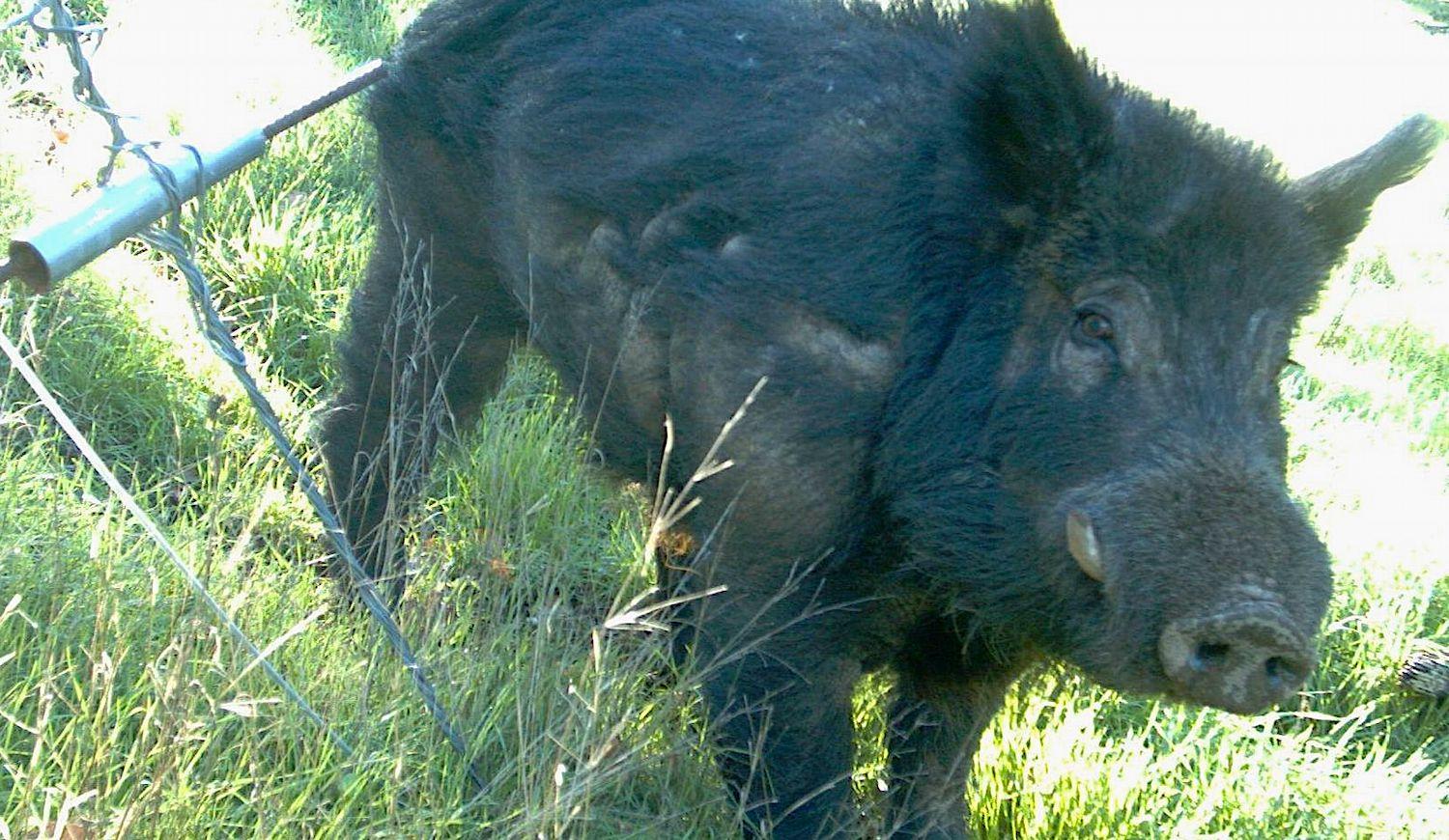
Aggressive efforts have almost eliminated feral hogs from Pinnacles National Park/NPS file
Measuring Successes Against Invasive Species
Feral pigs used to roam the chapparal and oak woodlands at Pinnacles National Park in California. Brought to the state in the 18th century to clear land, the pigs, weighing 100-200 pounds, rototilled through the soil and streams, killing salamanders, beetles, and aquatic invertebrates. In 2003, the park fenced out the pigs.
The solution worked flawlessly until this month.
Park staff spotted a juvenile pig exiting the park through a hole a coyote dug underneath the mesh wire fence. As of this writing, Pinnacles is relying on multiple cameras to spot other pigs, in addition to the monthly walks staff take to make sure the fence stays in good repair. Even with the breech, the park considers the fence effective. Now, there is less dispersal of nonnative plants, the park's oaks are regenerating, and the wetland habitat, important to the threatened California red-legged frog, is improving.
Circling Pinnacle's 24-mile-long perimeter, the 3.5-foot-high mesh fence allows other wildlife, including grey fox, desert cottontail, and mountain lions, to pass through or jump over. Based on an environmental assessment, the $3 million strategy recommended the installation of the fence and the eradication of 392 pigs inside the enclosure. The plan was deemed “the most ethically responsible alternative because it resulted in a finite number of pigs being euthanized,” said Paul Johnson, the park's wildlife biologist, in an email.
Across the country, there are examples of successful efforts to address the more than 4,500 nonnative species afflicting our national parks. But only a small percentage – about 10 percent of invasive animals and 3 percent of invasive plants -- are controlled. For those that are under control, human efforts supported by funding will likely be required forever.

Feral hogs in Cades Cove, Great Smoky Mountains National Park. / Meredith Boatman
Invasive Mammals And The National Parks
From hogs to cats to mountain goats, managing non-native mammals, which the public might find cute and endearing, is an ongoing challenge.
GREAT SMOKY MOUNTAINS NATIONAL PARK -- WHOOSH. It’s a warm, sunny autumn day in Great Smoky Mountains National Park, and I’m standing on the side of the main park road. Leaves have just begun turning gold, amber, and red, so the park is crowded with leaf-peepers. A steady stream of cars zooms past. WHOOSH. I try to ignore the traffic and pay attention to what Ryan Williamson, a park wildlife biologist, is showing me: a section of grass along the roadside that’s rutted and rooted up, like someone had gone off-roading with a miniature ATV.
The culprit? Feral hogs. In this case, Williamson believes it was a single feral hog that did the damage in this section along the road, citing reports of a lone pig seen near that stretch in the days before. After a moment, Williamson leads me deeper into the trees to an even larger, muddier area of ground disturbance, this time with wallows of standing water visible. Here is undeniable evidence of the damage that feral hogs do to the park landscape—uprooting native vegetation, creating new wet areas, and competing with native park wildlife for food and shelter.
“They pretty much just run along with their snout and turn the soil over and kind of like clean everything up that's edible,” Williamson says. “They pretty much are in direct competition with all of our native wildlife, so they eat a lot of acorns, a lot of seeds, a lot of nuts, a lot of tubers. All the things that our native wildlife eats, the hog directly competes with them for that.”
With:
Feral hogs are just one of several species of invasive mammals that are posing immense challenges for national park managers. Unlike invasive insects or reptiles, invasive mammals are often larger and more “charismatic” animals, difficult for parks to eradicate from a logistical, financial, and emotional perspective. Contributing writer Kim O'Connell goes in search of wild hogs at Great Smoky Mountains National Park with this Audio Postcard From The Parks.
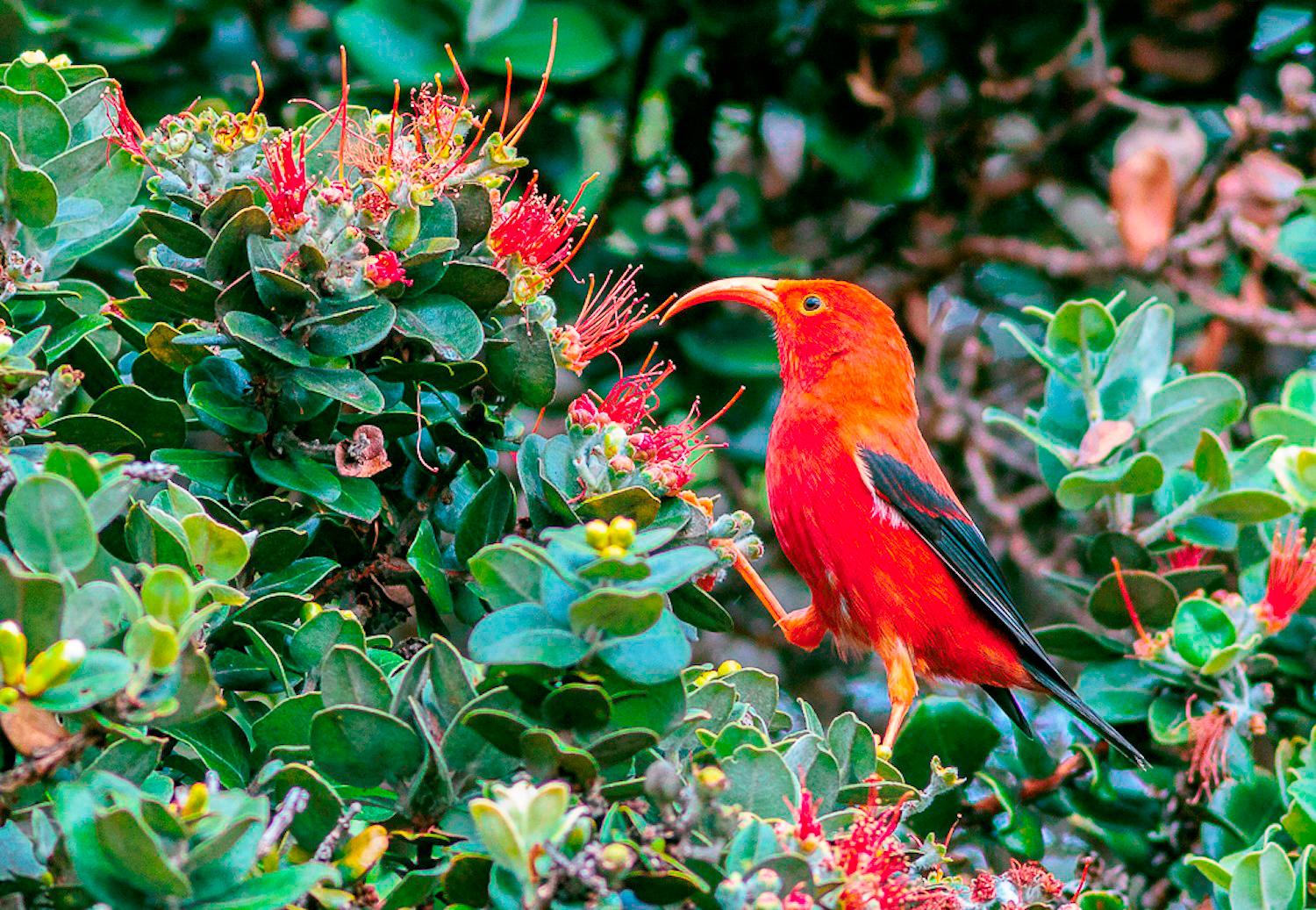
Disease-carrying mosquitoes pose a threat to endemic birds at Haleakalā National Park in Hawaii
Innovative Battles Against Park Invaders
With its sharp, hooked bill, the kiwikiu is a master at cracking open branches or berries in pursuit of a plump insect meal. Ironically, this olive green and yellow bird, already on the national endangered species list, risks being pushed into extinction by an insect not originally native to the Hawaiian islands.
The Hawaiian islands once counted more than 50 species of endemic forest birds, but today there are fewer than 17 species, according to the National Park Service, some with fewer than 500 individuals left.
The kiwikiu, a variety of honeycreeper also known as the Maui Parrotbill, is one of the dwindling species and is predicted to vanish from the Earth in just six years. Once abundant across Maui and Moloka'i, today fewer than 200 individuals are believed to be found across less than 8,000 acres on Maui in Haleakalā National Park, Hanawi Natural Area Reserve, and The Nature Conservancy’s Waikamoi Preserve.
A developing bid to save the species from extinction is just one example of how National Park Service staff is turning to technologies and innovative strategies for combatting invasive species that threaten to upend ecosystems, and their native inhabitants, in the National Park System.
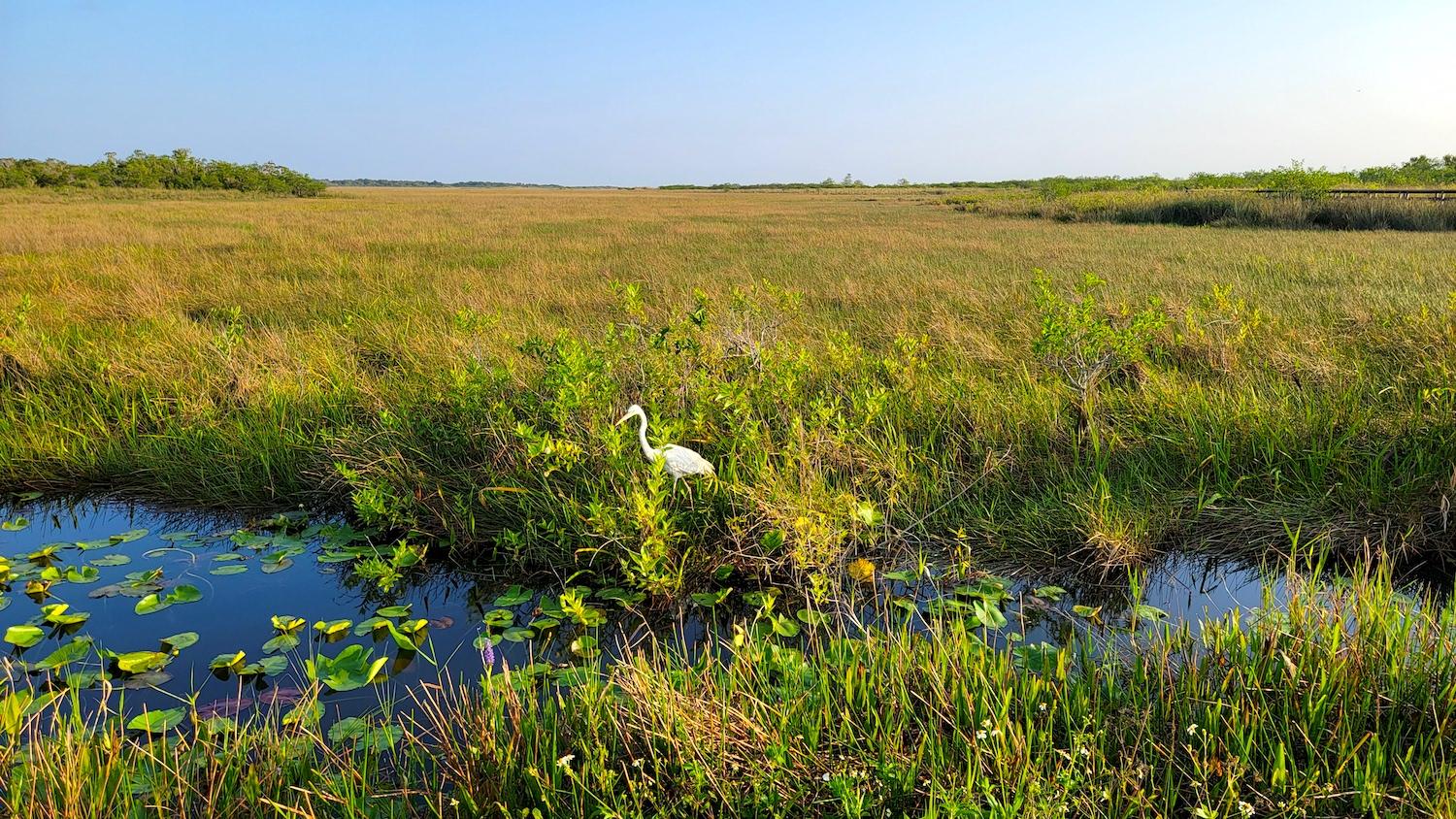
Everglades National Park: Ground Zero In The Battle Against Invasive Species
EVERGLADES NATIONAL PARK -- Poised, statue-like, in the sawgrass, the ivory-white heron might have been resting, or perhaps waiting for its next meal to come within view beneath its spindly legs. Across the way, an anhinga was resting on a tree branch, wings outstretched to catch the morning breeze to dry off. From my overlook on the boardwalk, an alligator drifted silently below through Taylor Slough.
It's impossible in just a handful of days to truly appreciate, and fully comprehend, Everglades National Park, a subtropical wilderness that has endured while much of Florida has been conquered by efforts to drain the swamp. Most of the park -- 1.3 million of the 1.5 million total acreage -- is out of reach to those who stay on the park road that runs from the Ernest F. Coe Visitor Center to Flamingo.
Still, driving that road brings into view not only the expansive sweeps of sawgrass prairie and occasional cypress domes, but more of those snowy white birds -- egrets -- great blue herons, red-shouldered hawks, and other birds that savor the marshes, cypress domes, and hardwood hammocks in the park. Birds such as the iconic roseate spoonbills, white ibis, wood storks and many dozens of others.
While much work and billions of dollars have been spent to restore the natural flow of the "river of grass" from Lake Okeechobee to Florida Bay, a rejuvenation that should pay huge benefits to the park's flora and fauna, on-the-ground battles continue against invasive predators that have been robbing the park of its small mammals and nonnative vegetation that has overwhelmed portions of the mesmerizing sawgrass prairie.

Restoring The Hole-In-The-Donut At Everglades National Park
EVERGLADES NATIONAL PARK _ It was an unlikely scene in a national park established to protect nature: bucket excavators, lumbering dump trucks, and bulldozers, heavy equipment more common at sprawling construction sites, were rummaging through the muck not far from the park's Ernest F. Coe Visitor Center.
They were not, however, deconstructing nature, but rather restoring it by recreating a natural environment conducive to the Muhly and sawgrass prairie near the southern end of Long Pine Key that once bordered Taylor Slough before giving way to tomato fields prior to Everglades National Park's establishment and then decades later, to a dense forest of nonnative Brazilian pepper trees.
"All of the farmland was acquired between 1970 and 1975," Jonathan Taylor, the park's restoration program manager, explained as we stood on the fringe of the excavation project. "The nice thing about this [tomato farming] is that they could do this during the winter when the rest of the United States was unable to produce fresh produce. And so it was a very profitable farm commodity. Harvest the tomatoes and send fresh tomatoes up to the rest of the United States."
Not long after the farming ended, however, the park's resource managers noticed that a new vegetation was creeping across the landscape, a nonnative plant from South America brought to the United States in the late 1890s and early 20th century as an ornamental tree. Reaching a height of 30 feet or so, the trees bear clumps of red berries that stand out against the green foiliage and explain their "Christmas holly" nickname.
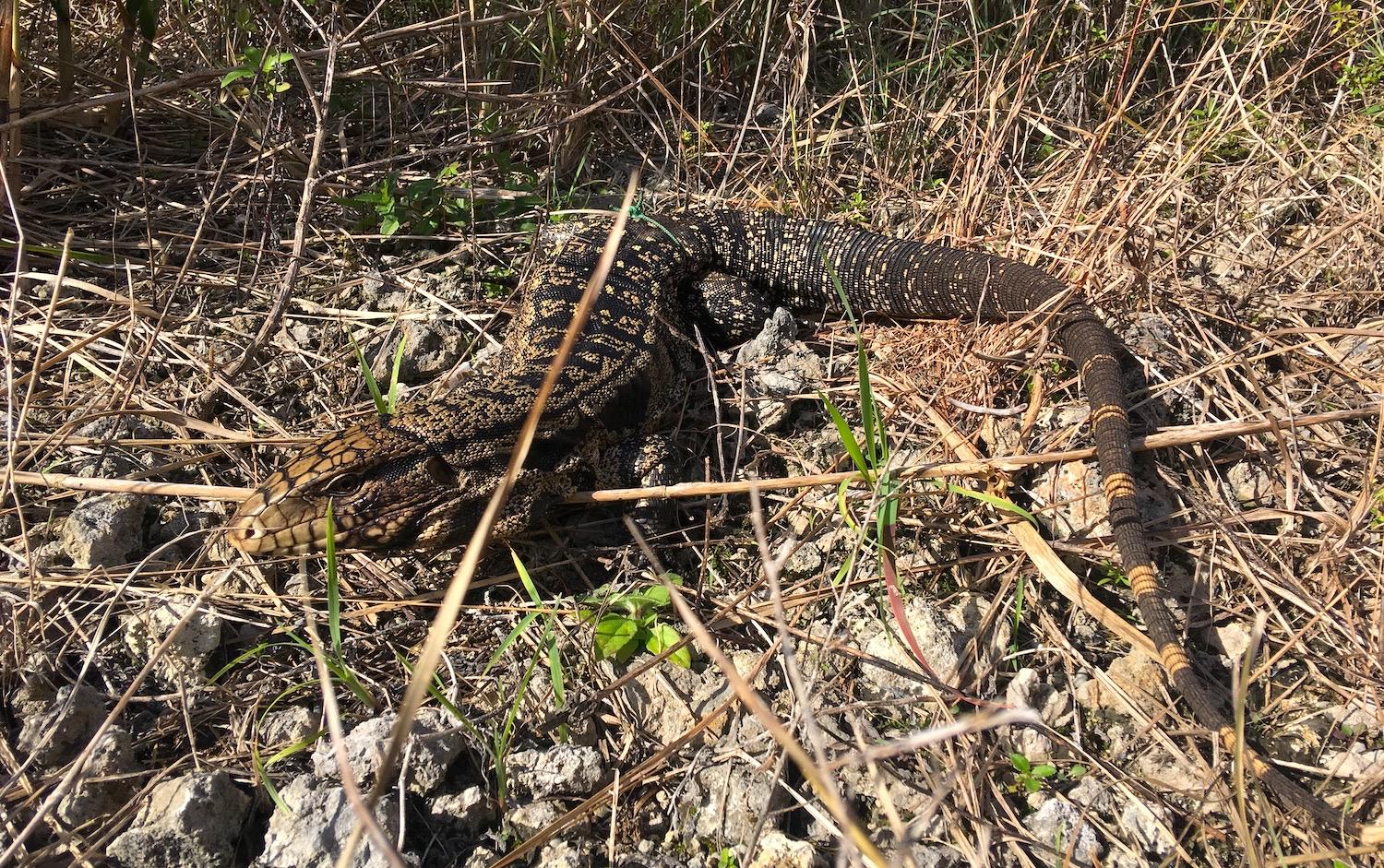
South American Invaders Trying To Gain A Foothold At Everglades National Park
EVERGLADES NATIONAL PARK __ Chicken eggs are pretty good chum, but alligator and crocodile eggs, sea turtle eggs, and even bird eggs are also high on the menu for black-and-white Argentine tegus, a lizard that arrived in Florida through the pet store trade and is threatening, along with other plant and animal species, to upend Everglades National Park's ecosystems.
Though probably not as destructive as Burmese pythons, another invader slithering through the park, tegus (Tay' goo) can grow to 4 or 5 feet in length, rob ground nests of their eggs, and quickly generate a population boom that challenges efforts to drive them out of Everglades.
"They can get up to 10 pounds," said Kevin Donmoyer, an invasive species biologist at the national park. "The size of a small dog. Captive tegus, there's plenty of material on the internet with big tegus walking around people's houses, hanging out with the dogs."
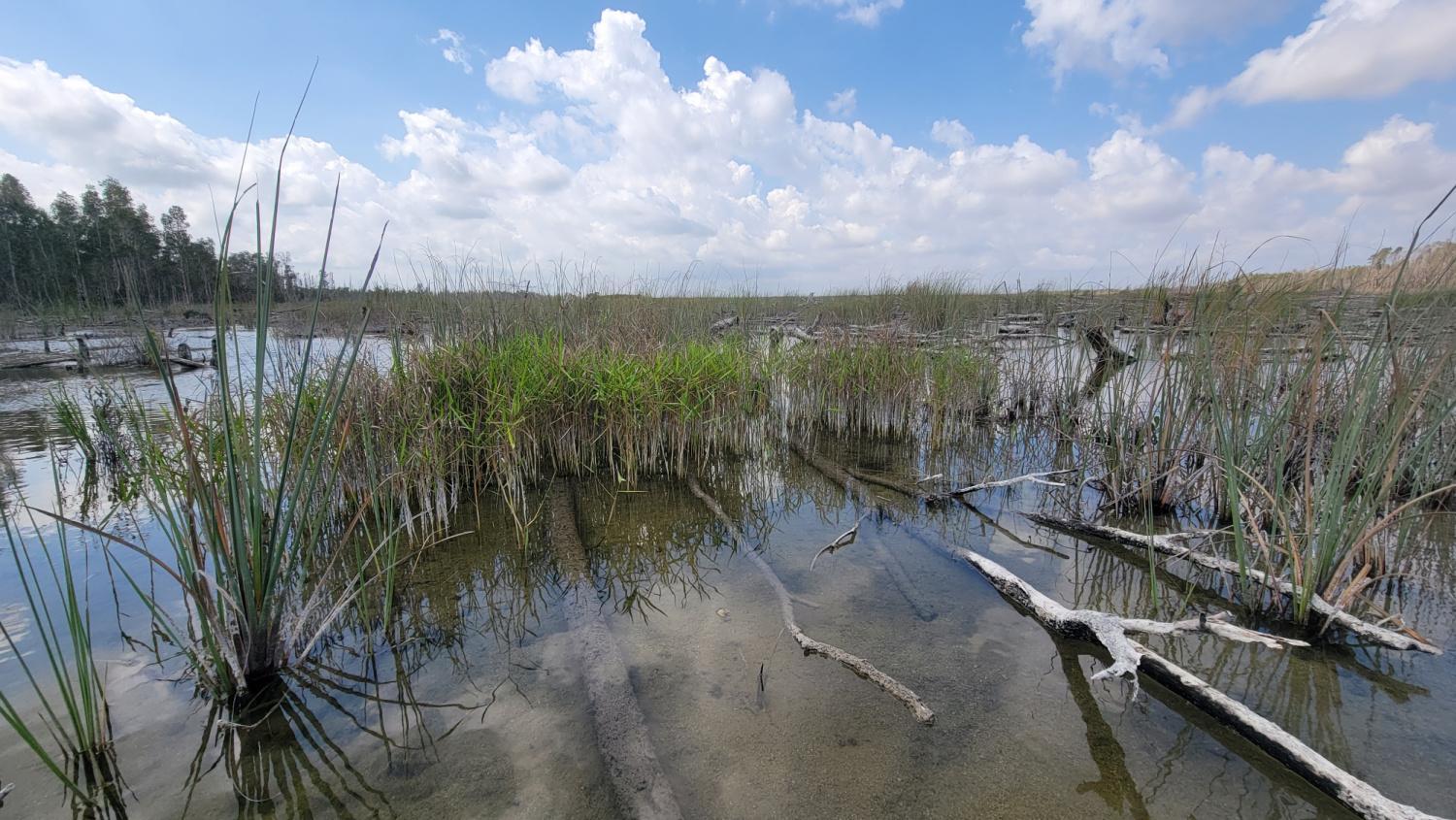
In a landscape once dominated by invasive melaleuca trees, whose husks can still be seen above and below the water, native plants are thriving once again. / Kim O'Connell
Progress Among The Paperbarks
The war against invasive vegetation is long and uncertain, but Everglades National Park is winning one important battle.
EVERGLADES NATIONAL PARK -- On a humid spring morning in Everglades National Park, Hillary Cooley points to what looks like an ancient book, with brittle pages yellowing under the harsh subtropical sun. Closer inspection reveals that it’s actually a large hunk of a melaleuca tree, also known as the broad-leaved paperbark. Along with river birch, sycamore, and paperbark maple trees, melaleuca bark curls and peels up in layers, like a snake shedding its skin.
Cooley is a botanist who heads up the park’s exotic plants management program. We are in the northeast corner of the national park, a section that was added to the park in the late 1980s, wading through water that reaches our ankles. All around us are melaleuca trees, some of which are flowering. Melaleuca flowers resemble white bottle brushes, giving the trees a feathery, fuzzy appearance when they are in bloom. Some branches carry dozens of seed pods or capsules—the melaleuca’s secret weapon. When those pods open, they release many thousands of seeds, carried away like dust by wind and wildlife. Some estimates say that a single mature melaleuca tree can produce 100 million seeds. “It’s fairly dramatic,” Cooley says.
As visually interesting as it is, however, the melaleuca tree is an invasive species, one of the most problematic plant species in the Everglades. First introduced to Florida from its native Australia in the late 19th century, the melaleuca was long prized as an ornamental species and gained widespread use as a shade tree and soil stabilizer. By the 1930s, officials were spreading melaleuca seeds over the Everglades by airplane, in a misguided attempt to dry up wetlands for more arable farmland. Melaleuca proliferated, eventually covering hundreds of thousands of acres in south Florida, and more than 5,000 acres in the national park alone.



Add comment